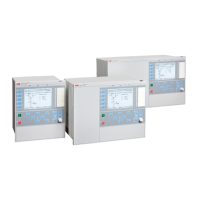7. Compare the measured time with the setting for tCoord.
8. Activate the BLOCK digital input.
9. Switch the fault current on (110% of the set operating current) and wait for a
period longer than the set value tCoord.
No TRIP signal should appear.
10. Switch the fault current and the polarizing voltage off.
11.
Reset the CR binary input and the BLOCK digital input.
13.12.1.2 Completing the test
Continue to test another function or end the test by changing the Test mode setting
to Off. Restore connections and settings to their original values, if they were
changed for testing purposes.
13.12.2 Current reversal and weak-end infeed logic for residual
overcurrent protection ECRWPSCH
Prepare the IED for verification of settings as outlined in section
"Overview" and
section "Preparing for test" in this chapter.
First, test the four step residual overcurrent protection function EF4PTOC and then
the current reversal and weak-end infeed logic according to the corresponding
instructions. Then continue with the instructions below.
13.12.2.1
Testing the current reversal logic
1. Inject the polarizing voltage 3U0 to 5% of UBase (EF4PTOC) and the phase
angle between voltage and current to 155°, the current leading the voltage.
2. Inject current (155° leading the voltage) in one phase to about 110% of the set
operating current of the four step residual overcurrent protection (IN>Dir).
3. Check that the IRVL output is activated after the set time (tPickUpRev).
4. Abruptly reverse the current to 65° lagging the voltage, to operate the forward
directional element.
5. Check that the IRVL output still is activated after the reversal with a time
delay that complies with the setting (tDelayRev).
6. Switch off the polarizing voltage and the current.
13.12.2.2 Testing the weak-end infeed logic
If setting
WEI
=
Echo
1MRK 504 088-UEN C Section 13
Verifying settings by secondary injection
195
Installation and commissioning manual

